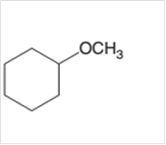
(a)
Interpretation:
The name of the following ether should be determined:

Concept Introduction:
Organic compounds are the compounds that are mainly composed of C and H atoms. The branch of chemistry that deals with the preparation, reactions, and properties of organic compounds are said to be
The structural formula represents all the bonded atoms with
(b)
Interpretation:
The name of the following ether should be determined:

Concept Introduction:
Organic compounds are the compounds that are mainly composed of C and H atoms. The branch of chemistry that deals with the preparation, reactions, and properties of organic compounds are said to be organic chemistry. The molecular formula of the organic compound represents the number of bonded atoms with their atomic symbols.
The structural formula represents all the bonded atoms with chemical bonds and the arrangement of atoms in the molecule. IUPAC purposed some rules to determine the name of an organic compound that is based on the number of C atoms in the longest chain of the compound and the name of branches.
(c)
Interpretation:
The name of the following ether should be determined:

Concept Introduction:
Organic compounds are the compounds that are mainly composed of C and H atoms. The branch of chemistry that deals with the preparation, reactions, and properties of organic compounds are said to be organic chemistry. The molecular formula of the organic compound represents the number of bonded atoms with their atomic symbols.
The structural formula represents all the bonded atoms with chemical bonds and the arrangement of atoms in the molecule. IUPAC purposed some rules to determine the name of an organic compound that is based on the number of C atoms in the longest chain of the compound and the name of branches.
Want to see the full answer?
Check out a sample textbook solution
Chapter 14 Solutions
General, Organic, & Biological Chemistry
- Give the complete IUPAC name for each of the following compounds: (a) (CH3)2CHF. (b) CH3CHClCHClCH3 (C) (d) CH3CH2CH = CHCH3 (e) (f) (CH3)3CCH2CCHarrow_forwardClassify each of the following hydrocarbons as saturated or unsaturated. a. CH3CH2CH3 b. CH3CH=CH2 c. CH3CCH d. CH3CH=CHCH3arrow_forwardWhat functional group distinguishes each of the following hydrocarbon derivatives? a. halohydrocarbons b. alcohols c. ethers d. aldehydes e. ketones f. carboxylic acids g. esters h. amines Give examples of each functional group. What prefix or suffix is used to name each functional group? What are the bond angles in each? Describe the bonding in each functional group. What is the difference between a primary, secondary, and tertiary alcohol? For the functional groups in ah, when is a number required to indicate the position of the functional group? Carboxylic acids are often written as RCOOH. What does COOH indicate and what does R indicate? Aldehydes are sometimes written as RCHO. What does CHO indicate?arrow_forward
- Complete and balance the following combustion reactions. Assume that each hydrocarbon is converted completely to carbon dioxide and water. (a) Propane + O2 (b) Octane + O2 (c) Cyclohexane + O2 (d) 2-Methylpentane + O2arrow_forwardClassify the following alcohols as primary, secondary, or tertiary: a. b.CH3CH2CH2CH2OH c.arrow_forwardWhat is the systematic name for this alkane? (a) nonane (b) 2-ethyl-5-methylhexane (c) 2,5-dimethyl heptane (d) dimethyloctanearrow_forward
- Arrange these compounds in order of increasing boiling point (values in C are 42, 24, 78, and 118). (a) CH3CH2OH (b) CH3OCH3 (c) CH3CH2CH3 (d) CH3COOHarrow_forwardThe following names are incorrect by IUPAC rules. Determine the correct IUPAC name for each compound. a. 2-Methyl-4-pentene b. 3-Methyl-2,4-pentadiene c. 3-Methyl-3-cyclopentene d. 1,2-Dimethyl-3-cyclohexenearrow_forwardThe following names are incorrect by IUPAC rules. Determine the correct IUPAC name for each compound. a. 2-Ethyl-2-pentene b. 4,5-Dimethyl-4-hexene c. 3,5-Cyclopentadiene d. l,2-Dimethyl-4-cyclohexenearrow_forward
- Draw the structural formula for 3-chlorohexanenitrile. O O O O O CT CH 3 CH ₂ CH CH ₂ CH ₂ CN CH 3 CH ₂ CH ₂ CH CH ₂ CH ₂ CN CI CH3 CH₂ CH₂ CH2 CH CH ₂ CN CI CH3 CH2 CH₂ CH CH ₂ CN दा CH3 CH ₂ CH CH ₂ CH ₂ CH ₂ CNarrow_forward3 OH PBr3 etherarrow_forwardClassify each alcohol as primary, secondary, or tertiaryarrow_forward
 Introduction to General, Organic and BiochemistryChemistryISBN:9781285869759Author:Frederick A. Bettelheim, William H. Brown, Mary K. Campbell, Shawn O. Farrell, Omar TorresPublisher:Cengage Learning
Introduction to General, Organic and BiochemistryChemistryISBN:9781285869759Author:Frederick A. Bettelheim, William H. Brown, Mary K. Campbell, Shawn O. Farrell, Omar TorresPublisher:Cengage Learning Chemistry by OpenStax (2015-05-04)ChemistryISBN:9781938168390Author:Klaus Theopold, Richard H Langley, Paul Flowers, William R. Robinson, Mark BlaserPublisher:OpenStax
Chemistry by OpenStax (2015-05-04)ChemistryISBN:9781938168390Author:Klaus Theopold, Richard H Langley, Paul Flowers, William R. Robinson, Mark BlaserPublisher:OpenStax Chemistry: Principles and PracticeChemistryISBN:9780534420123Author:Daniel L. Reger, Scott R. Goode, David W. Ball, Edward MercerPublisher:Cengage Learning
Chemistry: Principles and PracticeChemistryISBN:9780534420123Author:Daniel L. Reger, Scott R. Goode, David W. Ball, Edward MercerPublisher:Cengage Learning Organic ChemistryChemistryISBN:9781305580350Author:William H. Brown, Brent L. Iverson, Eric Anslyn, Christopher S. FootePublisher:Cengage Learning
Organic ChemistryChemistryISBN:9781305580350Author:William H. Brown, Brent L. Iverson, Eric Anslyn, Christopher S. FootePublisher:Cengage Learning ChemistryChemistryISBN:9781305957404Author:Steven S. Zumdahl, Susan A. Zumdahl, Donald J. DeCostePublisher:Cengage Learning
ChemistryChemistryISBN:9781305957404Author:Steven S. Zumdahl, Susan A. Zumdahl, Donald J. DeCostePublisher:Cengage Learning Chemistry: An Atoms First ApproachChemistryISBN:9781305079243Author:Steven S. Zumdahl, Susan A. ZumdahlPublisher:Cengage Learning
Chemistry: An Atoms First ApproachChemistryISBN:9781305079243Author:Steven S. Zumdahl, Susan A. ZumdahlPublisher:Cengage Learning





